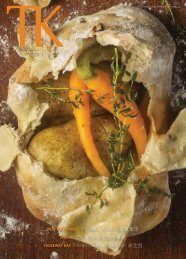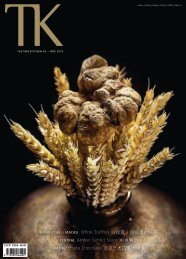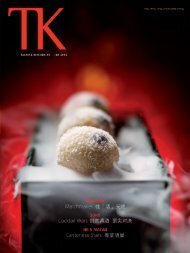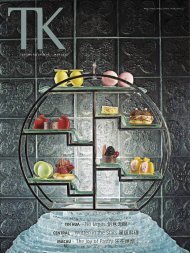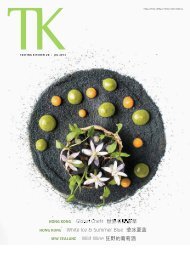Create successful ePaper yourself
Turn your PDF publications into a flip-book with our unique Google optimized e-Paper software.
food champions<br />
an egg sounds simple but it is hard to pull<br />
off. You have to get the timing exactly right,”<br />
says Asian Chairman of Escoffier Robert<br />
Fontana when asked why these dishes were<br />
selected to test the young chefs. “They also<br />
have to know how to prepare an artichoke<br />
perfectly, how to fillet a fish. Escoffier set<br />
all this out in his Guide. These chefs have<br />
to study him and know the traditional techniques<br />
backwards and forwards.”<br />
Now, the four remaining contestants<br />
must prepare a perfect steak, served medium<br />
rare, with a juicy center done nicely pink<br />
and the outside cooked just right to produce<br />
a dark caramelized crust. The steak<br />
is served with a béarnaise sauce, a classic<br />
Escoffier recipe requiring the chefs to work<br />
with steady hands as they combine egg yolks<br />
with a reduction of vinegar and tarragon and<br />
then add clarified butter over slow heat – get<br />
it wrong and the sauce may not cohere or fail<br />
to achieve the perfect creamy consistency.<br />
The scent of searing beef wafts over to<br />
the audience as the judges take their seats.<br />
There is a strict time frame. Eyck is unrelenting<br />
on punctuality. “Chefs need to make<br />
food when guests want it – not when they<br />
feel like it. It’s absolutely essential to get the<br />
timing right. One of the important things to<br />
factor in when cooking steak, is the amount<br />
of time the meat needs to rest before serving.<br />
The muscle fibers in the meat contract and<br />
you need to give them time to relax again, so<br />
the meat is tender to eat.”<br />
The chefs slice the meat and hands<br />
shake with nerves as they finish their plates.<br />
Macau’s chef whisks his béarnaise to a glossy<br />
thickness, tastes and pours. Vietnam’s chef,<br />
the only woman remaining in the competition,<br />
drags a spoonful of jus in a perfect line<br />
across her plate. The dishes are brought out<br />
and presented to the chefs who share a plate<br />
between two. The first thing they do is to<br />
check the warmth of the plates to ensure<br />
the food has been served piping hot. Their<br />
faces are stern as they sniff, prod and chew<br />
the meat. Spectators and competitors look<br />
on anxiously.<br />
The contest doesn’t end with the steak.<br />
The final hurdle is for the chefs to prove their<br />
pastry-making skills. “Pastry chef is actually a<br />
separate discipline,” explains Eyck, himself a<br />
pastry chef. “But all chefs need to know how<br />
to make basic desserts to a high standard.”<br />
The dish the contestants are preparing<br />
for their tough audience is a tarte flan aux<br />
pommes a la bataliere – a layered confection<br />
of pastry, sliced apples and creamy rice pudding<br />
topped with a delicate meringue. As the<br />
contestants set to work, the open kitchen<br />
fills with the sweet fragrance of apples frying<br />
gently in butter and spicy cinnamon.<br />
The apple tarts are paraded past the<br />
judges, then sliced and presented for tasting.<br />
The judges are looking for taste and<br />
texture, for a fine balance between the crumbly<br />
pasty, the silky meringue, the apples with<br />
just enough but not too much cinnamon,<br />
and the sweet nubbly texture of the rice.<br />
South Korea’s tart is producing murmurs of<br />
approval. “Nicely golden,” says one judge.<br />
“He’s put just the right amount of rice pudding<br />
on top,” says another. Tempting aromas<br />
tease the audience and everybody watches<br />
the judges as they taste and think and take<br />
notes, before retiring to a back room to discuss<br />
their findings.<br />
The four finalists are pale-faced and jittery<br />
after a solid three hours of hard and<br />
focused cooking. “When I am at work I am<br />
part of a team,” says Chris Wong, Hong<br />
Kong’s entrant. “I can ask other people in the<br />
team for advice and help. But in a competition<br />
like this I am all on my own in a strange<br />
kitchen.” They all admit to nerves and to<br />
their great desire to claim the Young Talent<br />
Trophy and to represent Asia while competing<br />
at the global final in France, where the<br />
great Escoffier once reigned.<br />
Finally the judges appear to announce a<br />
winner. South Korea’s Lee Yon Yong has done<br />
it with his perfectly balanced tart, which<br />
perfectly embodied the light refinement of<br />
Escoffier’s classic recipe.<br />
“I cannot believe that I am the victor of this<br />
competition. I just used traditional cooking<br />
skills,” says the champion. He looks surprised<br />
but beams proudly. “My coach told me<br />
to focus on taste and basic skills. I know my<br />
cooking doesn’t use enough salt, so I taste it.”<br />
And how will he prepare for the global<br />
final in France?<br />
“I’ll just keep practicing over and over.<br />
Competitions really stimulate my mind. I<br />
love this one.”<br />
48<br />
| TK | flavor dna<br />
FLAVOR <strong>DNA</strong> | TK | 49



